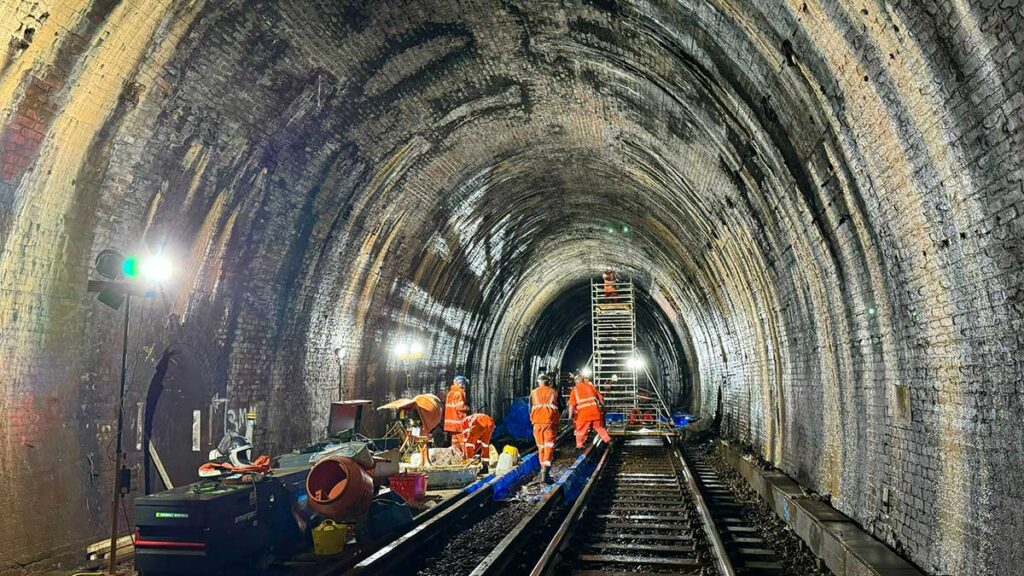Blackheath Tunnel Upgrade
From Sunday 18 May to Sunday 27 July 2025, the Blackheath tunnel between Blackheath and Charlton was closed as Network Rail undertook £10m of essential repairs to the 175-year-old Victorian-era structure.
The work this year, followed a 10-week closure last summer where engineers cleaned soot from the tunnel lining, carried out detailed surveys and replaced thousands of bricks to stop water leaking into the tunnel and damaging the railway.
The 175-year old Victoria-era tunnel has undergone a pioneering strengthening and waterproofing process, believed to be the first of its kind in the UK and potentially the world.

Why was the work needed?
The work was needed because the one-mile-long tunnel, which opened in 1849, is prone to leaks and water damage. This is due to brickwork damage caused by the freezing and thawing of rainwater which filters through the ground into the tunnel. While the tunnel is safe, the leaks and very wet conditions inside it damage track and electrical equipment, causing delays and speed restrictions. Over the last year, faults in the tunnel have been the cause of around 1000 minutes of delay to Southeastern passengers.
Delaying the work was not an option as the track and equipment in the tunnel would only deteriorate further causing an increase in delays and disruption to journeys.
Why was the work done over 10 weeks? Why wasn’t it done at weekends?
We know there’s never a good time to close the railway and that changes to services for a 10-week period was a long time.
A series of 10-week closures was needed because carrying out work in cramped and narrow tunnels is incredibly difficult. If traditional weekend working was used engineers would spend at least 50% of a weekend bringing materials and plant in and out of the tunnel, leaving limited time for actual repair work.
The alternative would have been a year of weekend closures, causing significantly more inconvenience for passengers.
What did we do?
Over the course of the entire programme of works, we replaced thousands of bricks and installed a new tunnel lining to stop water leaking into the tunnel, which will be crucial for the reliable running of the railway long into the future.
Engineers injected expansive grout into the pockets of sand and gravel surrounding the tunnel to strengthen the ground. This innovative technique knits and compresses the loose material tightly together.
A further layer of grout was applied to the back of the tunnel lining to waterproof the worst-affected areas, helping to preserve the brickwork and track, signalling, and other railway equipment in the tunnel for years to come.
Drainage systems were rebuilt and essential track work carried out, including ‘wet bed’ removal – these are waterlogged sections of track that cause bumpy train rides for customers. These additional works will mean less disruption for passengers in the long term.
What are the benefits?
With the tunnel repaired and water damaged infrastructure replaced, passengers will benefit from fewer delays, fewer speed restrictions and improved reliability.
Engineering by numbers
- 1,000 core holes drilled, stretching 900 metres – three times the height of The Shard or the length of Greenwich Park
- 4,000 injection tubes installed, totalling 13 kilometres – enough to reach from Blackheath tunnel to London Zoo
- 55 tonnes of grout used – equivalent to the volume of two swimming pools
- Tunnel monitoring system detects movement to 0.01 millimetres – less than the thickness of a human hair
- Peak workforce of over 100 people working day and night
Sign up for email updates
Sign-up with your email address to receive updates on the Blackheath Tunnel upgrade and information on projects taking place across the Southern region.
Our privacy notice applies to the personal information that Network Rail collects about you, or that you provide to us. It explains how and why we use your personal information, who we disclose it to and how we protect your privacy.
Get in touch
For more information call our National Helpline on 03457 11 41 41, visit our contact us page, or contact us on X @NetworkRailSE.